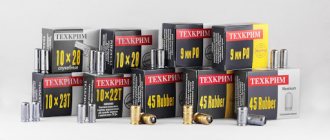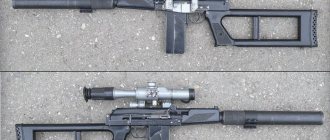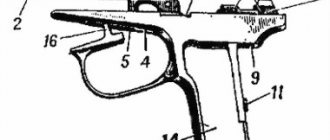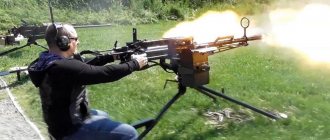Prospects for the development of the cartridge industry
General Director of JSC KBAL named after. L. N. Koshkina" Nikolay Maslyaev
The cartridge industry is a branch of ultra-mass production using high technologies, special technological equipment, and complex automation. It is a specialized scientific and industrial system that is important for the country's defense capability.
The structure of the cartridge industry has evolved over many decades and was dictated by the needs for small arms cartridges (SCA), amounting to hundreds of millions and billions of pieces per year.
The cartridge industry at all stages of its development, starting from 1869 (the beginning of its creation) and until 1991, had comprehensive government support.
As a result, in 1985–1991, the most powerful and modern production base was created, the basis of which was high technology and special technological equipment - high-performance automatic rotary lines. The Soviet Union became the largest producer of cartridges in the world - more than 6 billion per year.
At that time, the cartridge industry was represented by 9 factories - manufacturers of cartridges and special technological equipment for equipping cartridge production, as well as the main developer of technologies and equipment - the Design Bureau of Automatic Lines. Coordination of work related to the modernization and development of new cartridges was carried out, as at present, by TsNIITOCHMash.
Each cartridge plant for many years focused on the production of 1-2 main ranges of military cartridges with a certain specialization not only of the main production, but also of auxiliary structures (technical support service, tool production, testing base, etc.).
Since the early 90s of the last century, the situation has changed dramatically. There was a sharp reduction in state defense orders (SDO), the supply of live ammunition to foreign countries decreased significantly, and state support for the cartridge industry practically ceased in terms of financing the development of new technologies for the production of cartridges, the creation of advanced technological equipment and the modernization of production. The question arises: what are the reasons for this situation?
The adopted law “On Weapons” only partially helped solve the problem for individual enterprises. The factories were able to switch to the production of sporting and hunting cartridges and supply them mainly for export. The super-mass production of these cartridges, characterized by low price and high quality, helped keep some of the cartridge factories in Russia afloat, the main ones being Tula Cartridge Plant OJSC and Barnaul Cartridge Plant OJSC. These enterprises are capable of producing a sufficient number of cartridges today. At the same time, in our opinion, factories do not have the equipment for the widespread production of modern types of cartridges. Today, the state and interstate structures pay insufficient attention to the development of the cartridge industry in general, as well as cartridges and barrel-cartridge weapon systems in particular. Meanwhile, the role of cartridges in modern military conflicts is constantly increasing. If during the Great Patriotic War only 30–40% of the fire missions of combat units were carried out using small arms cartridges, then in modern military conflicts and local wars, and especially anti-terrorist and special operations, this figure reaches 90% or more.
Meanwhile, the situation with small arms ammunition is of serious concern. The age of the bulk of live ammunition in storage exceeds the guaranteed storage period of 25 years. A significant part of them is stored for more than the designated service life - 40 years. The cartridges accepted in previous years to supply the Russian army do not meet modern requirements for conducting combat operations in terms of penetration and accuracy of fire.
At a meeting held by the Chief of the General Staff of the RF Armed Forces on June 18, 2010 on the issue “Main directions of development and requirements for small arms and close combat weapons of the Armed Forces of the Russian Federation,” it was noted that taking into account the changes in the forms and methods of conducting combat operations in the approved “The concept for the development of combat equipment for military personnel of the main military specialties of the Ground Forces, Airborne Forces, Marine Corps of the Navy and special forces for the period until 2022” presents requirements that the existing system of small arms and close combat weapons does not satisfy.
Automatic equipment for the production of cartridges has been repeatedly awarded medals and diplomas
As shown by the analysis carried out during the formation of the “Comprehensive Targeted Program for Improving Combat Equipment”, the performance characteristics of the bulk of small arms need to be increased from 1.5 to 3 times. Practice shows that such an increase in the effectiveness of weapons can be achieved almost exclusively by increasing, mainly, the performance characteristics of the cartridge, increasing its power - bullet energy, stability of performance and uniformity of cartridges. Almost 90% of standard models of small arms and close combat weapons in service The Russian army, developed 30–50 years ago, are morally and technically outdated and cannot effectively solve problems determined by modern requirements. It should be noted, first of all, the troops are not satisfied with the main destructive element of the weapon - the cartridge.
It becomes obvious that increasing the efficiency of the cartridge, small arms and equipment in general can be achieved primarily by improving both the design of the cartridge and the technological processes of their production.
Now stocks of ammunition are burdening arsenals and bases. There is no need for mass production of existing cartridges. Therefore, the total volume of orders for cartridges can no longer ensure sufficient utilization of production capacity and the receipt of the required amount of financial resources for the sustainable operation of all cartridge factories. As a result, the renewal of special technological equipment developed by KBAL for the production of cartridges has ceased; the existing equipment is physically worn out and obsolete. In this regard, the technical re-equipment of factories and the improvement of production becomes problematic.
Today there is an urgent need to supply the market with automatic equipment for the production of cartridges with improved tactical and technical characteristics in small batches. And unused capacities after reconstruction of plants can be mothballed, with subsequent re-mothballing once every 5-7 years for prevention by releasing several batches of products.
The question rightly arises about the state of national, including military, security of Russia. The development of the described situation in the ammunition industry may lead in the coming years to the irretrievable loss of Russia's leadership in the production of modern small arms.
This is why, in our opinion, drastic measures are required to provide state support for a sufficient level of cartridge production in the country.
In total, the Russian Army currently supplies more than 120 types of small arms cartridges. The volume of new cartridges among them does not exceed 5 percent due to the small state defense order, the lack of new generation cartridges that meet the requirements of the Armed Forces, as well as modern technologies and equipment for their mass and selective production.
Thus, today, on the one hand, the volume of state defense orders has significantly decreased, equipment is wearing out and becoming obsolete, and on the other hand, there is a need for the development and adoption of promising selective action cartridges with increased tactical and technical characteristics. These problems must be solved comprehensively. It is necessary to work through the entire life cycle of the product – from preliminary design to disposal.
The main components of this approach may be: • modernization of the design of existing and development of new cartridges with increased tactical and technical characteristics based on the conditions of combat operations in modern military conflicts; • organization of special production for testing the industrial technology for manufacturing newly developed modern and experimental PSOs, as well as small batches of special cartridges; • reasoned, based on military doctrine, programs for the production of combat PSOs of the current and special period, taking into account the solution of current and special tasks not only by the Russian army, but also by other power structures of the Russian Federation, as well as exports; • ensuring the continuity of operation of cartridge production as the basis for determining the quality of produced cartridges, securing personnel and eliminating irreparable production costs; • unification of the main parameters of technological processes for the production of PSO, which is especially important in conditions of multi-product production and to ensure duplication of production in the conditions of a special period; • modernization of the existing fleet of equipment for cartridge production with an increase in production capabilities in terms of: maintainability, durability, mobility, introduction of modern control and automation equipment; • creation of modern, reconfigurable, automatic, modular equipment for the ongoing production of a wide range of PSO and high-performance equipment for use during a special period. Creation of a production base for its production; • an integrated approach to the disposal of PSO.
Modern packaging technologies ensure guaranteed storage of ammunition for 40 years
JSC "KBAL im. L.N. Koshkina, TsNIITOCHMASH, together with cartridge factories, often at their own expense, carry out experimental development of highly effective cartridges that can significantly improve the basic characteristics of small arms. This is exactly the strategy KBAL adheres to today. The company, including within the framework of the State Defense Order, is developing new types of cartridges, automatic rotary lines and technological processes for their production and disposal.
In the period from 1992 to the present, a number of modern cartridges have been developed and adopted for service. For pistols: 9x18 mm 7N25 cartridge with an armor-piercing bullet, 9x19 mm 7N21 cartridge with a steel core bullet, 9x19 mm 7N30 cartridge with a bullet with increased penetration, 9x21 mm 7N29 cartridge with a steel core bullet.
For machine guns: 5.45x39 mm 7N10 cartridge with a bullet of increased penetration, 5.45x39 mm 7N22 cartridge with an armor-piercing bullet, 5.45x39 mm 7N24 cartridge with an armor-piercing core, 5.45x39 mm 7BT4 cartridge with an armor-piercing tracer bullet.
For rifles: 7.62x54 mm 7N13 cartridge with a bullet of increased penetration, 7.62x54 mm 7N14 sniper cartridge with an armor-piercing bullet, 7.62x54 mm 7BT1 cartridge with an armor-piercing tracer BT bullet, 7.62x54 mm 7N26 cartridge with an armor-piercing BP bullet.
Special cartridges: 7.62 mm pistol cartridge 7N36 for silent and flameless shooting, 9x39 mm cartridge 7N9 with a sniper bullet of increased penetration, 9x39 mm cartridge 7N12 with an armor-piercing bullet.
I would also note that in connection with the massive equipping of manpower with personal protective equipment (body armor of various classes), the saturation of troops with lightly armored equipment, changes in the forms and methods of combat, the requirements for the effectiveness of small arms cartridges have increased, primarily in terms of increasing the penetrative effect, accuracy and firing range.
The use of cartridges with increased penetrating effect for ultra-precise shooting over long distances (1.5–2 km) significantly facilitates the solution of problems associated with the liquidation of terrorist organizations.
To ensure updating of the range of cartridges, it is necessary to improve the technological processes for manufacturing cartridges and special technological equipment for their production.
The process of loading a machine gun magazine with cartridges using a loaded plastic clip takes 1–2 seconds
One of the most important developments of the design bureau is the creation of a technological process and a complex of automatic equipment for loading cartridges into plastic clips and packaging cartridges, both with and without clips, in bags made of multilayer polymer films instead of seamless metal boxes. This will make it possible to open packages in combat conditions without any special tool, and the use of plastic clips will allow the equipment of a small arms store to be equipped in 1–2 seconds. For these purposes, JSC “Design Bureau of Automatic Lines named after L. N. Koshkin”, as part of the experimental design work “Fable”, “Packaging”, “Coating P”, “Cartridge N”, “Razryv” carried out work to improve the technological processes for manufacturing new generation cartridges and special technological equipment for their production and disposal.
The design bureau, together with cartridge factories, is capable in the near future of modernizing existing production facilities at industry factories, including by creating a universal complex of automatic, adjustable equipment with standard productivity (200–250 pcs./min.) for the production of a wide range of cartridges, both combat and for civil purposes, ensuring the required quality and profitability of production.
Based on the tasks assigned to this complex, it may include equipment of various classes, both automatic rotary or discrete, and separate for performing individual operations when producing small batches of special cartridges.
Simultaneously with modernization, it is necessary to create new “Module” type production facilities based on modern technological processes and equipment with an actual productivity of one chain of up to 800–1200 rounds per minute, which can ensure the production of PSO in a threatening period, outstripping their consumption during the most intense period of a large-scale military conflict . It is proposed to mothball such “Modules”.
To complete the life cycle of cartridges, our design bureau, when carrying out the Razryv R&D project in 2007, created a working technological process for recycling 5.45 mm cartridges; 7.62 mm; 9 mm and a set of special technological equipment for recycling. The technological process ensures the division of the cartridge into its main elements, collection of gunpowder, thermal demercurization of the primer in the cartridge case, ensuring environmental, fire and explosion safety.
Individual elements of the cartridge (case) can be reused in the production of ammunition for sporting and hunting weapons or sold (lead) as recyclable materials, and the gunpowder is sent for recycling to specialized chemical plants. Further work is being carried out to optimize the process of chemical demercurization of the primer.
The location of production for the recycling of cartridges, taking into account its specifics, is permissible at specialized enterprises, for example, at one of the existing cartridge factories in Russia, or directly at the bases and arsenals of the Ministry of Defense using a mobile version of the equipment complex, also developed by JSC KBAL im. L.N. Koshkina.
In a word, recycling today is a costly process, but the reuse of PSO elements, including for the production of cartridges for civilian weapons, will minimize costs, and recycling in a mobile complex will, in addition, reduce the costs of transporting and protecting dangerous goods, as well as reduce fire and the explosion hazard of the entire disposal cycle.
Foreign economic cooperation is important for the industry, both in the supply of military and sporting and hunting cartridges, and in the creation of cartridge production abroad.
Of course, without the support of the state, through the efforts of enterprises alone, it is impossible to reform the ammunition industry. In this regard, government, economic, political, and social measures are needed to ensure the production of PSO in Russia.
Together with the holding parent organization OJSC IZHMASH, OJSC KBAL im. L.N. Koshkina" is developing a program for the integrated development of enterprises producing small arms systems and ammunition. Proposals have also been developed and submitted to the targeted federal “Armament” program.
At the same time, in our opinion, government support for the development of the production of small arms and ammunition in the country is required.
We believe that at the first stage it is necessary to finance the research work carried out by the research institutes and design bureaus of the cartridge industry on their own initiative. Payment could be made based on the results of state tests of samples of cartridges and equipment for their production, developed by the method of scientific and technical groundwork.
In our opinion, the implementation of the proposed measures will allow: • to improve the quality of stored ammunition through timely renewal of stocks; • reduce unreasonable costs for their storage; • minimize the costs of disposal of PSO; • create a mobilization complex in the future.
Ultimately, these measures will help revive the cartridge industry, update the technological base of cartridges, TsNIITOCHMash, and provide the Russian Armed Forces with cartridges that meet the most modern requirements.
Russia faces the risk of losing its largest ammunition market
The import of cartridges from Russia to the United States in the eight months of this year reached $114 million - almost the same as for the entire last year (about $118 million), according to US customs data. The average annual figure for the last ten full years is $102 million. Russia accounts for more than 21% of total imports of gun cartridges into the United States for 2022, this is the first place among suppliers (in second place is South Korea with an indicator half as much, in third place is the Czech Republic ).
Read on RBC Pro
The Federal Tax Service wants to take taxes for sports and lunches for employees. What the courts say
Why is the Central Bank introducing a digital ruble and how can it be used?
Failed miserably: 5 major PR failures of 2022 - Bloomberg
Why Bill Gates is buying up farmland and how to follow his example
Russian cartridges provide about 4% of the entire American firearms market, taking into account the US’s own production (about 9.7 billion cartridges), Jurgen Brauer, an economist at the industry consulting company Small Arms Analytics & Forecasting, told The Firearms Blog in September. According to the company, in 2022, US importers imported more than 765 million rounds of ammunition from Russia (total imports from all countries amounted to about 3.5 billion rounds).
In the early 2000s, 70–80% of cartridges produced in Russia were exported, recalled Viktor Murakhovsky, editor-in-chief of Arsenal of the Fatherland magazine. According to him, the lion's share of these exports went to the American market. “We cannot say that the situation has changed much by 2022. Almost all Russian cartridge manufacturers rely on exports. The US has the largest ammunition market in the world. Individual gun ownership is widespread there, there are many shooting clubs, and a developed shooting culture,” the expert noted.
How do these sanctions work?
The supply of Russian ammunition to the United States will not stop immediately due to sanctions. The restrictions introduced are formulated as follows: “New or already submitted but not yet approved applications for permission to import firearms or ammunition from Russia <...> will be rejected.”
At the same time, American importers had the theoretical opportunity to have time to issue fresh import permits in the interval between the announcement of sanctions and their implementation, although it usually takes four to six weeks to process an application from an importer (according to US Customs and Border Protection).
Licenses to import small arms and ammunition into the United States for civilian use (the import of such products for military purposes is generally prohibited by American law) are administered by the Bureau of Alcohol, Tobacco, Firearms and Explosives (ATF) of the US Department of Justice. Accordingly, imports under permits already issued (which are legally valid for two years) can continue. Therefore, if a US company, for example, received permission to import a certain amount of Russian ammunition in July 2022, the import of this amount could continue until mid-2023.
As The Firearms Blog explains, in order to obtain an ATF permit, the importer fills out the so-called Form-6, in which, among other things, he declares the quantity of goods he plans to import (for example, 20 million rounds of 7.62 mm ammunition from Russia produced by a certain ammunition factory ). If the form is approved, those 20 million rounds can be imported in as many batches as desired, and each one is declared to US Customs via Form-6A (which does not require approval). According to The Firearms Blog, US importers with Form-6s approved before September 7 can continue to import Russian ammunition within the remaining volumes and time frames provided for by the permit. It is impossible to estimate from public sources how much Russian ammunition remains to be imported into the United States and until when.
The fact that deliveries of Russian cartridges continue within the framework of existing import permits is indirectly indicated by data from the ImportGenius customs database: there, for example, there is information about the arrival of shipments from the Barnaul Cartridge Plant and the Novosibirsk Cartridge Plant to American importers on September 15, that is, after the date of sanctions by virtue of.
Do Russian ammunition manufacturers need state support?
Since 2014, the United States has imposed sanctions against many Russian defense-industrial companies - for example, against the Kalashnikov concern. But most ammunition factories remained outside the restrictions. Only the Tula Cartridge Plant (TPZ) group suffered from US financial restrictions in 2018: its then beneficiary Igor Rotenberg was included in the sanctions list of the US Treasury Department, and payments from American customers due to TPZ were blocked according to the “50% rule” (this was reported in the plant’s reporting, it itself was not included in the US sanctions list). In 2022, Rotenberg withdrew from the capital of TPZ, and sanctions against the company, according to the rule, should have ceased to apply. However, it is unclear how TPZ is perceived by the compliance departments of its potential counterparties: as of the end of 2022, the funds of the US plant have not been released, and the current beneficiaries of TPZ are not disclosed.
Due to sanctions, domestic manufacturers of small arms and ammunition are losing about 10 billion rubles. revenue per year, said Sergei Abramov, who held the position of industrial director of the arms cluster of the Rostec state corporation in 2019.
The Barnaul Cartridge Plant lists among its partners such American companies as DKG Trading, Academy Ltd., Sporting Supplies International and MKS Supply. The owner of the latter, Charles Brown, told the industry portal Guns & Ammo on August 21 that his company has been approved to import several million Barnaul cartridges, but these supplies “will expire very quickly.” In his opinion, sanctions could worsen the existing shortage of ammunition in the United States and lead to an increase in retail prices for them. RBC sent inquiries to representatives of several American importers.
For some cartridge manufacturers, contracts with buyers may be valid at least until the end of 2022, Vladimir Zhikharev, executive director of the Russian Gunsmiths Union, noted in an interview with RBC. Therefore, the main question now is whether enterprises will be able to complete existing contracts, he said. This, in turn, depends on American importers whether they managed to obtain permission to import ammunition before these sanctions came into force. In each specific case, the situation is different, says RBC's interlocutor. In general, contract volumes/delivery dates and import permits do not have to coincide (for example, a contract in theory can be valid until 2025, but an import permit can only be valid until 2022).
“If the American importer has received import permission for the entire contract, the Russian enterprise will supply the entire contract. If permission is received for only one cartridge, then the importer will receive one cartridge,” Zhikharev explained. A significant part of Russian-made cartridges is export-oriented, Zhikharev noted, but, according to him, it is difficult to name a specific share. According to the reports of the Tula Cartridge Plant for 2022, 46% of its sales come from exports (financial reports of other cartridge factories could not be found in the public domain).
“This product is very specific. At the same time, we know that weapons manufacturers have been under sanctions since 2014 and have been able to find new markets. With cartridges, finding your niche will be a little more difficult. But, I’m sure, this is also a matter of time and state support, which cartridge manufacturers need in connection with the new sanctions,” concluded Zhikharev.
Since August, work has been organized with industry enterprises to develop a set of measures of both a regulatory and financial nature, the press service of the Ministry of Industry and Trade told RBC. These measures are aimed at compensating for the decline in demand and ensuring sustainable operation of the ammunition industry, the ministry noted. “The main areas of work have been identified, and corresponding action plans and proposals for support from the state are being developed,” the press service of the Ministry of Industry and Trade reported, without specifying how exactly the assistance could be implemented.
Dropped out of the clip: how sanctions affected the production of cartridges in Russia Politics
What forms of government assistance are possible?
“There is a possibility of providing state support [to the cartridge industry], and, most likely, it will be provided. Another thing is that this state support will not apply to all producers,” says independent economist Vladimir Tikhomirov. In his opinion, as a result of American sanctions, industry consolidation (unification of players) and, accordingly, a reduction in total production are possible. State support can take the form of low-interest loans, an increase in state defense orders for ammunition, or direct subsidies to enterprises.
TPZ notes in its reporting for 2022 that in the event of a ban on the supply of products in the importing country, the company will seek additional orders in the domestic market, including through the development of new products, but will also “involve the federal authorities in solving the problem.”
According to Small Arms Analytics & Forecasting, ammunition sales in the United States total approximately 12 billion units annually. There is no such demand anywhere; Russian producers simply have nowhere to redirect the flow, Murakhovsky emphasizes. “The state defense order will not be able to cover these losses, because usually, when we talk about the state defense order, we mean the renewal of reserves, and not some large [additional] supplies,” he explained. There is no official information about the domestic cartridge market in Russia (for example, Rosstat does not publish data on production volumes of weapon cartridges).
There is no need to wait for a revision of the sanctions, the expert is convinced, and the Russian share in the American market will most likely be captured by other suppliers. “Some share will also be taken by Balkan factories, which once had a Soviet license for the production of ammunition; the licenses have long expired, but despite this, the factories continue production,” concluded Murakhovsky.
General Director of the Novosibirsk Cartridge Plant Svyatoslav Dobrynin told RBC that “we do not comment on this issue to the press.” The Amur cartridge plant, as well as the Barnaul, Tula and Klimovsky cartridge factories, did not respond to RBC’s request. American importers of Russian ammunition also left their requests unanswered.
RBC sent inquiries to the government and the Ministry of Defense.
Ammo shortage
The coronavirus pandemic and record sales of ammunition in the United States have already led to a shortage in the market. According to American media reports, amid the coronavirus panic, people lined up to buy weapons and ammunition. Along with the increase in sales, the price also increased. In July this year, National Shooting Sports Foundation director of communications Mark Oliva said the influx of new buyers over the past year and a half has led to empty shelves and high prices. “A 5.56 mm round for an AR-15 assault rifle used to cost about 33 cents, now its price is close to a dollar. So ammunition has become much more expensive, and it is much more difficult to find it,” he stated.
Against the backdrop of sanctions, Russia sold a record amount of ammunition to the United States in 30 years
What is driving the record deliveries?
In September of this year, Russian ammunition ]faced the risk[/anchor] of losing their largest sales market - the American one. The reason was additional American sanctions announced on August 20 due to accusations against Russia of involvement in the poisoning of opposition leader Alexei Navalny.
These sanctions limit the “ongoing import” into the United States of small arms and ammunition from Russia by refusing to grant new licenses to American importers to import these products; the sanctions came into force on September 7. After each year, they can be canceled, but this requires the US President to formally assure Congress that Russia has abandoned the use of chemical weapons and agrees to compensate Navalny for the damage.
Read on RBC Pro
The Federal Tax Service wants to take taxes for sports and lunches for employees. What the courts say Why the Central Bank is introducing a digital ruble and how it can be used Failed miserably: 5 main PR failures of 2022 - Bloomberg Why Bill Gates is buying up agricultural land and how to follow his example
According to the UN, more than 94% of all Russian cartridges exported go to the United States and only a little to the European Union ($2.7 million in 2022), Canada ($1.5 million), Thailand ($0.6 million). The Russian Federal Customs Service does not disclose the export volumes of cartridges.
Russia faces the risk of losing its largest market for cartridges Business
How American importers managed to temporarily circumvent sanctions
American importers had a theoretical opportunity to have time to issue fresh import permits in the interval between the announcement of sanctions and their implementation, RBC noted. Such licenses, administered by the U.S. Department of Justice's Bureau of Alcohol, Tobacco, Firearms and Explosives (ATF), are legally valid for two years, and imports under permits issued before the sanctions took effect can continue.
The American partners of the Tula Cartridge Plant (TPZ), one of the largest Russian cartridge manufacturers, have a valid license that will expire in the fall of 2023, according to a source close to TPZ. “For two more years everything will be fine, and then problems will appear. Because we won’t be able to replace this market in any way,” he said, noting that the company currently employs about 2 thousand people. The press service of the Tula Cartridge Plant declined to comment.
Economist at the industry consulting company Small Arms Analytics & Forecasting (SAAF), which tracks trends in the American firearms market, Jurgen Brauer confirmed to RBC that American importers of Russian cartridges managed to obtain new two-year licenses in the interval between the announcement of sanctions and their entry into force, without specifying details . He said that in this regard, he expects continued supplies of Russian ammunition to the United States until at least the fall of 2023.
An ATF representative told RBC that the bureau was processing applications from American companies on Form 6 (ATF Form 6) for permanent imports from Russia until September 7, the date the sanctions came into force. “Import permits on Form-6 are valid for two years or until all goods identified on the form are imported, whichever comes first,” ATF said. As RBC previously wrote, the importer, in order to obtain ATF permission, fills out the so-called Form-6, in which, among other things, he declares the quantity of goods that he plans to import (for example, 20 million cartridges from Russia of 7.62 mm caliber produced by a certain cartridge factory) .
How much ammunition does Russia supply to the USA?
Since the early 1990s, Russia has supplied about $1.7 billion worth of firearms ammunition to the United States, according to open US customs data.
Russian cartridges provide about 22% of all cartridge imports into the country and about 4% of the entire American firearms market, including its own production, which is estimated at approximately 9.7 billion cartridges. According to SAAF, in 2022, US importers imported more than 765 million rounds of ammunition from Russia (total imports from all countries amounted to about 3.5 billion rounds).
“Almost all Russian cartridge manufacturers rely on exports. The US has the largest ammunition market in the world. Individual ownership of weapons is common there, there are many shooting clubs, and a developed shooting culture,” noted Viktor Murakhovsky, editor-in-chief of Arsenal of the Fatherland magazine.
Are the authorities going to support cartridge factories?
The Federal Service for Military-Technical Cooperation did not comment to RBC on the increase in supplies of cartridges to the United States, since “we are talking about cartridges for civilian weapons.” In the office of Deputy Prime Minister Yuri Borisov, who oversees the military-industrial complex, RBC's request was forwarded to the Ministry of Industry and Trade.
The Ministry of Industry and Trade reported to RBC that the increase in supply volumes to the United States is associated with a significant increase in demand for cartridges in this country in the last two to three years. Compared to 2022, the volume of supplies of Russian ammunition for civilian small arms to the United States has almost tripled, the ministry noted. “This is not related to the imposed sanctions,” the Ministry of Industry and Trade emphasized.
Work on developing measures aimed at supporting ammunition industry enterprises after the imposition of sanctions by the United States is currently ongoing, the ministry reported. “It is too early to talk about its results until the proposed measures are agreed upon at all levels,” the Ministry of Industry and Trade concluded, refusing to specify what kind of support measures they are talking about.
Russian cartridges are in demand in the United States due to the fact that they are usually cheaper than their American counterparts, notes the American media Raw Story. Overall, gun sales in the United States have skyrocketed during the pandemic and there has been a shortage of ammo in the market. The US National Rifle Association (NRA) is “exploring all political, legislative and legal options to combat the new policy” of sanctions against Russian cartridges, Raw Story cites a statement from NRA lobbyists.











